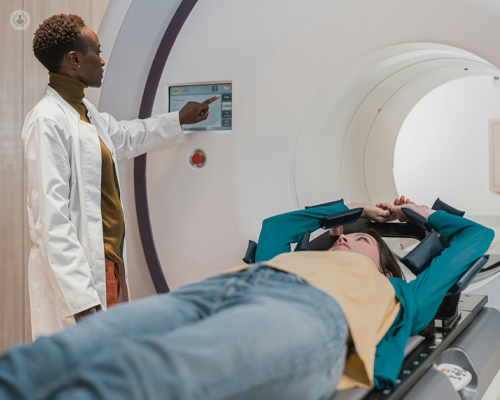The MRIdian – an advanced MR linac
Escrito por:The MRIdian is a groundbreaking technology that combines high-resolution magnetic resonance imaging (MRI) with precise radiotherapy to treat tumours with exceptional accuracy. Known as magnetic resonance image-guided radiotherapy (MRIgRT), this method offers significant advantages over conventional radiotherapy by enabling real-time visualisation of tumours and their movement during treatment.

What are the benefits of MRIdian?
Accurate targeting
The MRIdian uses real-time MRI to continuously monitor the exact location and shape of the tumour throughout treatment. This allows for precise targeting of the radiation beam, ensuring it hits only the tumour while sparing surrounding healthy tissues.
Greater control and precision
Uniquely, the MRIdian offers automated beam control. If the tumour moves, even slightly, during the procedure, the system will automatically pause the radiation beam until the tumour returns to its optimal position. This feature reduces the risk of damaging nearby organs and tissues.
Reduced side effects
Because the radiation is so precisely targeted, the likelihood of side effects is significantly reduced compared to conventional radiotherapy, which often affects healthy tissue around the tumour. This increased accuracy means fewer complications and a better quality of life for patients.
Fewer treatment sessions
Where traditional radiotherapy may require up to 37 sessions, the MRIdian's focused precision means that many patients only need five sessions. This not only reduces the overall treatment time but also minimises disruption to patients' daily lives.
Who can benefit from MRIdian treatment?
More than 20,000 people worldwide have already benefitted from MRIdian treatment, particularly those with tumours located near vital organs or in areas that are prone to movement, such as the lungs, liver and pancreas. The MRIdian’s precision makes it suitable for treating:
- Lung cancer
- Pancreatic cancer
- Prostate cancer
- Kidney cancer
- Liver cancer
It's also beneficial in cases where cancer has metastasised (spread to other areas) and in treating areas previously irradiated, where additional radiation poses greater risk.
What does MRIdian treatment involve?
The process involves four key stages:
- Simulation appointment
Before starting treatment, a simulation scan will be performed to assess your tumour and determine the most accurate treatment plan. You’ll be briefed on preparation instructions during this appointment. - Planning
Your care team will use the simulation data to create a detailed plan tailored to the size, shape, and location of your tumour. This plan ensures the radiation dose is delivered with maximum precision. - Treatment
The actual treatment typically involves five sessions, either over alternate days or consecutively, depending on your condition and location of the tumour. Each session is quick, with real-time MRI imaging ensuring the radiation is delivered only when the tumour is in the correct position. - Follow-up
After treatment, follow-up appointments will monitor your progress and check for any side effects. The care team will provide ongoing support and guidance throughout your recovery.
What are the side effects of MRIdian treatment?
The side effects of MRIdian treatment, for example: for lung cancer, can vary based on the tumour's location within the lungs and its proximity to other organs. Here is a breakdown of possible short- and long-term side effects patients may experience during and after lung radiotherapy with MRIdian.
Short-term side effects
During the treatment course, patients may notice certain side effects, which usually subside within three to four weeks. Common short-term effects include:
- Fatigue: A general feeling of tiredness, which is common in most radiotherapy treatments.
- Dry cough: Often a mild and manageable symptom.
Less commonly, patients may experience:
- Inflammation of lung tissue: This can cause discomfort and may need management.
- Shortness of breath: This may arise but is usually mild.
- Fever: A less common response but one to monitor.
- Skin reactions: Skin may show signs of redness (in people with lighter skin tones) or darkening (in people with brown or black skin) near the treatment area.
Long-term side effects
Long-term effects of MRIdian radiotherapy are largely influenced by the tumour’s position and proximity to nearby organs. Attending follow-up appointments is vital to monitor, detect, and address any issues early on. Your consultant will discuss which, if any, of these side effects that you may be likely to experience, and they will provide advice on managing them effectively. For example, some patients may experience lasting fatigue, minor respiratory issues or very localised changes in skin colour.
In addition to physical follow-ups, psychological support and wellbeing therapies are also available.
The MRIdian represents a major advancement in cancer treatment, offering unparalleled precision and reduced side effects. It is particularly useful for tumours located near critical organs and for patients requiring re-irradiation. With fewer treatments needed, it offers an effective and more comfortable experience for patients undergoing radiotherapy.


